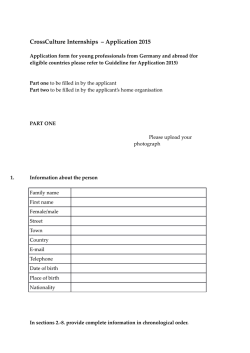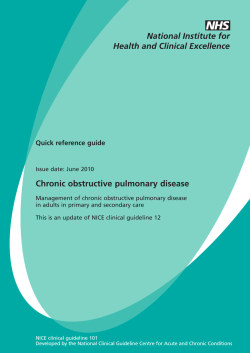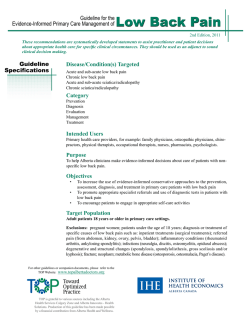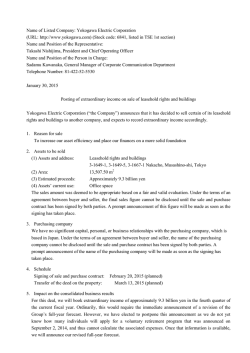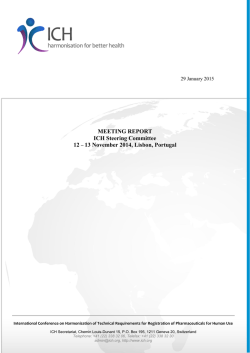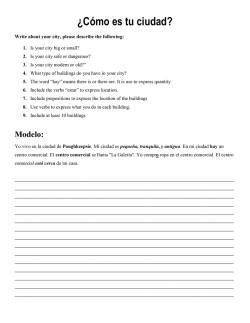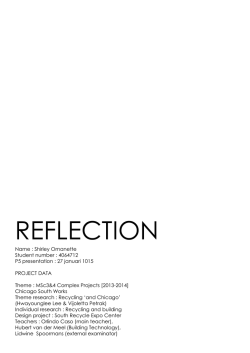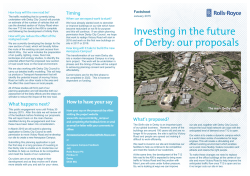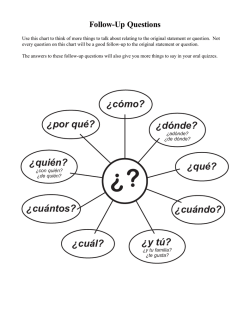
CFPA_E_Guideline_No_01_2014_F - CFPA
CFPA-E No 1:2014 F Fire protection management system CFPA-E-GUIDELINES FOREWORD The European fire protection associations have decided to produce common guidelines in order to achieve similar interpretation in European countries and to give examples of acceptable solutions, concepts and models. The Confederation of Fire Protection Associations in Europe (CFPA E) has the aim to facilitate and support fire protection activities across Europe/work in European/work in the European countries. The market imposes new demands for quality and safety. Today, fire protection forms an integral part of a modern strategy for survival and competitiveness. This guideline “Internal Fire Protection Control” gives a method for a systematic fire protection work. This guideline is primarily intended for those responsible for safety in companies and organisations. It is also addressed to the rescue services, consultants, safety companies etc. so that, in the course of their work, they may be able to help companies and organisations to increase the levels of fire safety. The proposals within this guideline have been produced by the Swedish Fire Protection Association and the author is Lars Rang from Sweden. This guideline has been compiled by Guidelines Commission and adopted by all fire protection associations in the Confederation of Fire Protection Associations Europe. These guidelines reflect best practice developed by the countries of CFPA Europe. Where the guidelines and national requirement conflict, national requirements must apply. Zürich, October 2014 CFPA Europe Madrid, October 2014 Guidelines Commission Jesper Ditlev Chairman Miguel Vidueira Chairman CFPA-E-GUIDELINES 3 GUIDELINE No 1:2014 F Content 1 2 3 4 5 6 7 8 9 10 11 12 13 Introduction ................................................................................................................ 4 Scope ......................................................................................................................... 4 Fire safety policy.......................................................................................................... 5 Action plan .................................................................................................................. 5 Management of fire protection ...................................................................................... 7 Training plans.............................................................................................................. 7 Rules and routines ....................................................................................................... 7 Business continuity planning ......................................................................................... 7 Documentation of buildings and activities ...................................................................... 7 Control system ............................................................................................................ 8 Documentation ............................................................................................................ 9 Follow-up system ......................................................................................................... 9 European guidelines ..................................................................................................... 9 CFPA-E-GUIDELINES 4 GUIDELINE No 1:2014 F 1 Introduction The aim of this fire protection management system is to secure the company´s activities without business interruptions, in other words, it´s important for the survival of the company. Demands for quality and safety are continuously becoming more important. Being responsive to customer concerns is an essential factor for success. Good relations are just as important as products and services. Business between companies is also characterised by increasing demands for quality. The open European market makes it essential to formulate systems to secure competence, precision of delivery, environmental considerations and ethics. Many companies and organisations have established a systematic way of working with fire protection such as, set up goals, pinpoint risks, organise, train, check, document and follow-up their activities. This guideline is a tool that facilitates the work to make fire protection a part of your company´s management system. 2 Scope This guideline includes the following elements in the fire protection management system, briefly described below: Fire safety policy Fire protection organisation Fire risk management Rules and routines Emergency preparedness Training plans Documentation of buildings and activities Control system Follow-up system CFPA-E-GUIDELINES 5 GUIDELINE No 1:2014 F 3 Fire safety policy For the fire protection activity of the company, management must establish its fire protection policy. The fire protection policy is a statement of results to be achieved and sets out the fundamental principles and safety level which shall apply for fire protection in the business. Before the policy is confirmed, the risks associated with the activity must be identified and the consequences which would ensue if these occurred must be evaluated. An appropriate fire protection policy for the company is as follows: The company shall have: 1. Active leadership for fire protection issues 2. Management of fire protection 3. Plans for training in fire protection 4. Fire protection rules and routines 5. Business continuity planning 5. A description of buildings including fire protection 6. Operating and maintenance instructions for fire protection 7. A control system for fire protection 8. Follow-up procedures for fire protection The policy will then form the basis for the development of fire protection work in the total management system. 4 Action plan An action plan for the company’s fire protection activity should be drawn up so that those responsible for the development of the different components may be appointed. The start and completion dates and the budgets for the different components must be specified. CFPA-E-GUIDELINES 6 GUIDELINE No 1:2014 F Works to be performed: Identify fire hazards and assess the consequences of a fire Review fire protection - regarding the building structure - regarding the organisation Establish a fire protection organisation - determine responsibilities and tasks Establish rules and routines for e.g. smoking, welding, waste handling, flammable substances etc. Make plans for how to manage and recover from a business interruption Put together documentation of building and activities including fire protection systems as - escape routes - fire compartments - extinguishing equipment Establish operating and maintenance instructions for the fixed fire protection system Establish a control system for fire protection Develop procedures for reporting and monitoring fire protection - technical defects and deviations - organisational defects and deviations - recovering measures Establish follow-up procedures and how to develop the fire protection management system CFPA-E-GUIDELINES Person responsible Start Completed Budget 7 GUIDELINE No 1:2014 F 5 Management of fire protection The company organisation for fire protection work must be clearly set out. Within the company there must be a person who has overall responsibility for the management of fire protection as well as individuals who have been given written specifications of their duties and powers. The fire protection manager and the fire protection surveyors shall be given the required training. 6 Training plans The aim is to make all personnel aware of fire safety issues in the workplace. They must be able to act on their own initiative and to play their part in ensuring that the company has proper fire protection. The fire protection manager and other responsible persons may need additional specialist training. 7 Rules and routines With the help of fire protection rules and routines, the fire risks can be limited or eliminated. The fire protection rules should explain what measures that everyone involved should do to reduce the risks. The fire protection rules and routines are your tool in achieving the greatest possible fire safety at a place of work. Rules and routines should be constantly reviewed and be a part of the information in training activities. 8 Business continuity planning A business continuity plan is a plan to continue operations if a place of business is affected by adverse physical conditions, such as a storm, fire or crime. Such a plan typically explains how the business would recover its operations or move operations to another location. For example, if a fire destroys an office building or data center, the people and business or data center operations would relocate to a recovery site. The plan could include recovering from different levels of disaster which can be short term, localized disasters, to days long building wide problems, to a permanent loss of a building. More information about this item is published in CFPA E Guideline No 2 2013 N, business resilience. 9 Documentation of buildings and activities Documentation of buildings and activities shall be provided to be used when communicating with authorities and other external stakeholders. CFPA-E-GUIDELINES 8 GUIDELINE No 1:2014 F In order that the fire protection manager (and also the fire protection surveyors) may understand and control the technical design of fire protection, he will need drawings and other descriptions of the fire protection systems. It is essential that these drawings etc. should be produced by your own organisation; knowledge is then available where it is most needed. Drawings of the building generally depict the fundamental protection which is required by way of loadbearing and separating structures, escape routes and protection against surface spread of flame, etc. These drawings often provide a good basis for you to build upon and to produce a description of fire protection, and to keep it up to date. A complete description of fire protection comprises drawings and text concerning fire compartment boundaries, escape routes, access routes for the rescue service, ventilation of fire gases, the fixed extinguishing system, positioning of fire extinguishers, etc. It also shows the storage and handling of flammable and explosive substances, and plans for the classification of these substances. The descriptions should set out the current conditions, preferably by means of uniform or standardised symbols. When the fire protection system is inspected, the description will be used by the fire protection surveyors as a joint basis for the inspection. 10 Control system Fire safety is not achieved unless the fixed fire protection systems are controlled systematically and continuously. Control of the fire protection systems shall be carried out regularly and preferably by the fire protection surveyors appointed in the company. The control is to be based on the description of fire protection and the operating and maintenance instructions. Control implies that a large quantity of data and information must be collected and effectively processed. Depending on the quantity of information and the control requirements, the tools you will use to have a proper overview of this information will vary. It is today increasingly common to use computers for the collection and processing of data. When you have established the inspection areas, inspection techniques and procedures, you can determine the inspection intervals. It is essential that the internal control activity should not become a matter of superficial routine. Control shall be carried out properly, and a lot of imagination and ingenuity may be needed to increase the interest and commitment of those who perform the inspections. In-house control of the electrical equipment should also form part of the regular inspections. It is at all times the duty of the owner of the plant to maintain his plant in such a condition that it provides the necessary safety for people, domestic animals, and property in accordance with the requirements of the appropriate authorities. CFPA-E-GUIDELINES 9 GUIDELINE No 1:2014 F 11 Documentation Documentation should consist of a report on how the different components of the fire protection policy have been performed. The documentation must reflect the way control activity functions. Documentation is important for those who are responsible for fire safety in the company, and it is also of interest for the auditor, fire inspector and the representatives of the insurer, etc. 12 Follow-up system This refers to a summary report on the inspections, both external and internal, which are carried out within the company. This summary is to be regarded as an aid for the chief fire protection officer and managing director in monitoring that these controls have been carried out, and it will also enable them to improve fire protection. It is appropriate for reports on incidents to be included in this summary. Incident reporting means that information concerning the equipment in which fire incidents occurs, and the causes of these incidents, is collected and compiled. The aim of incident reporting is to help the company to identify the risks in the company and to make it easier to assess the probability of occurrence of a certain event that may result in a fire. 13 European guidelines Fire Guideline Guideline Guideline Guideline Guideline Guideline Guideline Guideline Guideline Guideline Guideline Guideline Guideline Guideline Guideline Guideline Guideline Guideline Guideline Guideline Guideline Guideline No. No. No. No. No. No. No. No. No. No. No. No. No. No. No. No. No. No. No. No. No. No. 1:2014 2:2013 3:2011 4:2010 5:2003 6:2011 7:2011 8:2004 9:2012 10:2008 11:2005 12:2012 13:2006 14:2007 15:2012 16:2008 17:2014 18:2013 19:2009 20:2012 21:2012 22:2012 CFPA-E-GUIDELINES F F F F F F F F F F F F F F F F F F F F F F - Fire protection management system Panic & emergency exit devices Certification of thermographers Introduction to qualitative fire risk assessment Guidance signs, emergency lighting and general lighting Fire safety in care homes for the elderly Safety distance between waste containers and buildings Preventing arson – information to young people Fire safety in restaurants Smoke alarms in the home Recommended numbers of fire protection trained staff Fire safety basics for hot work operatives Fire protection documentation Fire protection in information technology facilities Fire safety in guest harbours and marinas Fire protection in offices Fire safety in farm buildings Fire protection on chemical manufacturing sites Fire safety engineering concerning evacuation from buildings Fire safety in camping sites Fire prevention on construction sites Wind turbines – Fire protection guideline 10 GUIDELINE No 1:2014 F Guideline Guideline Guideline Guideline Guideline Guideline Guideline Guideline Guideline No. No. No. No. No. No. No. No. No. 23:2010 24:2010 25:2010 26:2010 27:2011 28:2012 29:2013 30:2013 31:2013 Securing the operational readiness of fire control system Fire safe homes Emergency plan Fire protection of temporary buildings on construction sites Fire safety in apartment buildings Fire safety in laboratories Protection of paintings: Transport, exhibition and storage Managing fire safety in historical buildings Protection against self-ignition and explosions in handling and storage of silage and fodder in farms Guideline No. 32:2014 F - Treatment and storage of waste and combustible secondary raw Materials Natural hazards Guideline Guideline Guideline Guideline Guideline Security Guideline Guideline Guideline Guideline Guideline F F F F F F F F F - No. No. No. No. No. 1:2012 2:2013 3:2013 4:2013 5:2014 N N N N N - Protection against flood Business Resilience – An introduction to protecting your business Protection of buildings against wind damage Lightning protection Managing heavy snow loads on roofs. No. No. No. No. No. 1:2010 2:2010 3:2010 4:2010 5:2012 S S S S S - Arson document Protection of empty buildings Security system for empty buildings Guidance on key holder selections and duties Security guidelines for museums and showrooms. CFPA-E-GUIDELINES
© Copyright 2024
